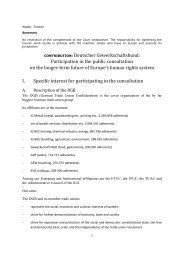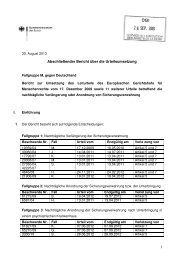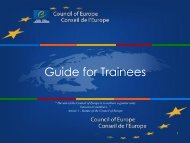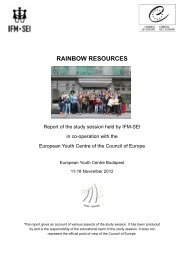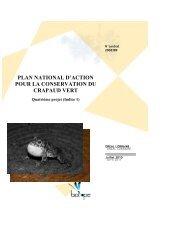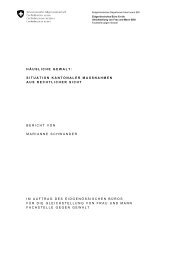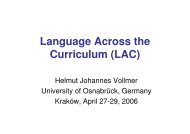From India to Europe - Council of Europe
From India to Europe - Council of Europe
From India to Europe - Council of Europe
Create successful ePaper yourself
Turn your PDF publications into a flip-book with our unique Google optimized e-Paper software.
CounCIL ConSEIL<br />
oF EuRoPE DE L´EuRoPE<br />
iSTANBul<br />
ANkARA<br />
cAiRO<br />
iNTRODucTiON<br />
PROJecT<br />
eDucATiON OF<br />
ROMA chilDReN<br />
iN euROPe<br />
<strong>From</strong> <strong>India</strong><br />
<strong>to</strong> <strong>Europe</strong><br />
BYZANTiuM: PelOPONNeSe (13 th ceNT.); ASiA MiNOR (10-11 th ceNT.?)<br />
DAMAScuS<br />
RiAD<br />
MeccA<br />
The Roma’s indian origin is uncontested.<br />
By analysing Romani, the language<br />
<strong>of</strong> the Roma, and comparing it with<br />
other languages, it could be shown that<br />
the Roma migrated from central india<br />
<strong>to</strong> the eastern parts <strong>of</strong> Northern india,<br />
and probably stayed there for some<br />
time. Then, they possibly moved via<br />
Persia and Armenia <strong>to</strong> the Byzantine<br />
empire, <strong>to</strong> Asia Minor and later on <strong>to</strong><br />
Greece. linguistic findings point at a<br />
fairly homogenous group which arri-<br />
BAGhDAD<br />
BAku<br />
ARMeNiA?<br />
PeRSiA?<br />
TeheRAN<br />
AShABAD<br />
NORThWeST iNDiA (eND OF 2 nd hAlF OF The 1 st MilleNNiuM c.e.)<br />
kABul<br />
ceNTRAl iNDiA (1 st hAlF OF The 1 st MilleNNiuM c.e.)<br />
ved in the Byzantine empire, because<br />
all groups <strong>of</strong> Roma existing <strong>to</strong>day have<br />
a common linguistic basis, which also<br />
includes parts <strong>of</strong> lexicon and grammar<br />
taken from Greek.<br />
Also according <strong>to</strong> more recent,<br />
preliminary findings <strong>of</strong> population genetics,<br />
the Roma’s ances<strong>to</strong>rs were indian.<br />
These were supposedly part <strong>of</strong> a<br />
relatively small homogenous group, as<br />
shown by analyses <strong>of</strong> blood groups. Differentiations<br />
within this group probably<br />
only occurred at the time <strong>of</strong> their arrival<br />
and their early spread in<strong>to</strong> europe.<br />
MuMBAi<br />
ROMA | hiSTORY<br />
<strong>From</strong> IndIa<br />
<strong>to</strong> EuropE<br />
compiled by the edi<strong>to</strong>rs<br />
<strong>India</strong> | Moving West | The Way <strong>to</strong> Byzantium – the Lexicon as Map? | Dom, Luri, Roma: Cousins, but not<br />
Siblings | Roma in the Byzantine Empire | The Athingani | Roma on Peloponnese<br />
According <strong>to</strong> the findings <strong>of</strong> linguistics, cultural anthropology, science <strong>of</strong> his<strong>to</strong>ry and, in more<br />
recent years, population genetics, the Roma’s <strong>India</strong>n origin is considered a fact. How their ances<strong>to</strong>rs<br />
came from <strong>India</strong> <strong>to</strong> <strong>Europe</strong>, and when this migration <strong>to</strong>ok place, its reasons and who exactly these<br />
people were is, however, open <strong>to</strong> assumptions. For want <strong>of</strong> direct evidence, the pre-<strong>Europe</strong>an his<strong>to</strong>ry<br />
<strong>of</strong> the Roma is a matter <strong>of</strong> reconstruction.<br />
Delhi<br />
1.0<br />
MiGRATiON FROM iNDiA TO euROPe<br />
ill. 1<br />
Areas and most likely dates <strong>of</strong> sojourn.<br />
NAGPuR<br />
Just like linguistics and genetics,<br />
cultural anthropology assumes that the<br />
Roma originally came from india. it refers,<br />
among others, <strong>to</strong> socio-cultural institutions<br />
like the traditional form <strong>of</strong> jurisdiction,<br />
or <strong>to</strong> certain rules within the groups,<br />
such as the commands <strong>of</strong> cleanness. Both,<br />
group-internal jurisdiction and the commands<br />
<strong>of</strong> cleanness, can also be found,<br />
like certain religious notions <strong>of</strong> some<br />
groups <strong>of</strong> Roma, on the indian subcontinent.<br />
Direct socio-cultural connections<br />
between the Roma and indian groups,<br />
however, have so far not been established.
<strong>India</strong><br />
Moving West<br />
The Way <strong>to</strong> Byzantium – the Lexicon as Map?<br />
ill. 2<br />
<strong>From</strong> a 16th-century Persian manuscript:<br />
Shangul <strong>of</strong> <strong>India</strong> entertained by Bahram Gur.<br />
(from Fraser 1992, p. 34)<br />
Science <strong>of</strong> his<strong>to</strong>ry has sources at<br />
its disposal which do not talk about the<br />
Roma, but about groups which are reminiscent<br />
<strong>of</strong> the Roma in many respects,<br />
IndIa<br />
linguistic methods make it possible<br />
<strong>to</strong> determine the spatial and temporal<br />
origin <strong>of</strong> an indo-Aryan language. Particularly<br />
changes within the sound system<br />
<strong>of</strong> a language make it possible <strong>to</strong><br />
movIng WEst<br />
The precise time when the Roma left<br />
india is unknown. linguistic data cannot<br />
provide precise dates, and there are<br />
no contemporary documents about the<br />
Roma’s migration through the Middle<br />
east. it is only later writers who refer<br />
<strong>to</strong> events <strong>of</strong> those times, always from<br />
a distance <strong>of</strong> many centuries. in his<br />
SOMe iMPORTANT lANGuAGeS OF The iNDiAN SuBcONTiNeNT<br />
Central Indo-Aryan languages and some sorrounding other Indo-Aryan, Iranian<br />
and Dravida languages.<br />
kAShMiRi<br />
ill. 3<br />
ARABiAN SeA<br />
Central Indo-Aryan Languages<br />
Iranian Languages<br />
Dravida Languages<br />
BAlOchi<br />
Other Indo-Aryan Languages<br />
PAShTO<br />
SiNDhi<br />
uRDu<br />
and which have been equated with them<br />
in the past. None <strong>of</strong> these assumptions<br />
could be proved; yet such documents<br />
from Persia and the Arabian region allow<br />
draw conclusions as <strong>to</strong> earlier origins.<br />
Romani, however, cannot be classified<br />
easily. it has many features <strong>of</strong> the socalled<br />
central indo-Aryan languages,<br />
like hindi-urdu, Panjabi, Gujarati or<br />
the Rajasthani group, but it also shares<br />
features with Northern indo-Aryan languages<br />
like kashmiri. <strong>From</strong> this, and<br />
other considerations, it has been conclu-<br />
“Shahnameh” (The Book <strong>of</strong> kings),<br />
written in 1011, the Persian poet Ferdowsi<br />
mentions a legend according<br />
<strong>to</strong> which the indian king Shangul<br />
gave his Persian colleague Bahram V<br />
(420-438) 10,000 so-called “luri” as<br />
a present, <strong>to</strong> entertain the latter’s people<br />
with music. Bahram gave the luri<br />
crops <strong>to</strong> sow for their service; they ate<br />
the corn and asked for more. consequently,<br />
the Shah sent the luri out in<strong>to</strong><br />
the world on the back <strong>of</strong> their animals.<br />
PANJABi<br />
RAJASThANi<br />
GuJARATi<br />
MARAThi<br />
kANNADA<br />
MAlAYAlAM<br />
hiNDi<br />
ORiYA<br />
TeluGu<br />
TAMil<br />
NePAli<br />
BihARi<br />
BeNGAli<br />
BAY OF BeNGAl<br />
SiNhAleSe<br />
ASSAMeSe<br />
us <strong>to</strong> form a picture <strong>of</strong> the nomadic population<br />
in those regions in which the Roma<br />
travelled in all likelihood in the course <strong>of</strong><br />
their migration from india <strong>to</strong> europe.<br />
ded that the Roma’s ances<strong>to</strong>rs originally<br />
lived in central india. Already before<br />
the common era, they moved <strong>to</strong> Northwestern<br />
india, where they stayed for<br />
a longer period <strong>of</strong> time, before leaving<br />
this area and moving west. This theory,<br />
postulated in 1927 by the British specialist<br />
in oriental studies Ralph Turner, is<br />
commonly accepted <strong>to</strong>day. [ills. 1, 3]<br />
Similar legends are <strong>to</strong>ld by other his<strong>to</strong>riographers.<br />
[ill. 2]<br />
During Bahram V’s reign there<br />
is actual evidence <strong>of</strong> the immigration <strong>of</strong><br />
various Northern indian groups in<strong>to</strong> the<br />
Persian area. Some researchers identified<br />
the “luri” (called “Zott” or “Jatt”<br />
in Arabian sources) with the Roma and<br />
consequently assumed that they had left<br />
india already in the 5 th century. Thus,<br />
also the lack <strong>of</strong> Arabian words in the<br />
Romani lexicon was explained: during
CounCIL oF EuRoPE<br />
PROJecT eDucATiON OF ROMA chilDReN iN euROPe<br />
ROMANi – A MODeRN iNDO-ARYAN lANGuAGe<br />
The original Indo-Aryan words in Romani have great morphosyntactic<br />
potency, which means that it is possible <strong>to</strong><br />
create, with a number <strong>of</strong> specific suffixes, out <strong>of</strong> one word a<br />
number <strong>of</strong> other words:<br />
ROMANi<br />
bar-o<br />
bar-ipen<br />
bar-ikanipen<br />
bar-ikanarel pes<br />
bar-arel<br />
bar-arel avri<br />
bar-arel pes<br />
bar-uvel (barol)<br />
bar-eder<br />
Similar <strong>to</strong> these features, a significant part <strong>of</strong> Romani grammar<br />
is Indo-Aryan; <strong>to</strong>day’s Romani is considered a Modern<br />
Indo-Aryan language.<br />
ill. 4<br />
the 7 th century, Persia came under Arabian<br />
reign, and Romani included Persian,<br />
but no Arabian words in its lexicon. As<br />
a result, it has been concluded that the<br />
Roma had left Persia before the Arabian<br />
conquest. The legend about the luri<br />
could thus very well refer <strong>to</strong> the Roma,<br />
who left Persia already in the 5 th century,<br />
and india even earlier on their westward<br />
journey.<br />
These conclusions, however, do<br />
not necessarily appear convincing. Firstly,<br />
there are several versions <strong>of</strong> the luri<br />
legend, which differ in decisive issues,<br />
and which were recorded only 500 years<br />
thE Way <strong>to</strong> ByzantIum<br />
– thE LExIcon as map?<br />
The lexicon <strong>of</strong> Romani (that is the vocabulary<br />
<strong>of</strong> the Roma’s language) is divided<br />
in<strong>to</strong> an older, pre-european lexicon, and<br />
a younger, european lexicon by linguists.<br />
The pre-european lexicon comprises<br />
the indo-Aryan, Persian, Armenian and<br />
Greek words in Romani. it is more or less<br />
shared by all Romani-speaking people.<br />
eNGliSh<br />
large, big; powerful; elder<br />
size, distinction, pride<br />
pretentiousness<br />
<strong>to</strong> enlarge<br />
<strong>to</strong> primp and preen, <strong>to</strong> overdress<br />
<strong>to</strong> raise children<br />
<strong>to</strong> brag<br />
<strong>to</strong> grow<br />
<strong>of</strong>ficer (literally the “bigger” one)<br />
after the alleged event. The reliability<br />
<strong>of</strong> such sources can be judged by looking<br />
at the “legends” about the Roma’s<br />
origin circulating <strong>to</strong>day. if one was <strong>to</strong><br />
search these legends for his<strong>to</strong>rical facts,<br />
other than the fact that a long time ago a<br />
then unknown people came <strong>to</strong> europe, it<br />
would be in vain. [ill. 5]<br />
Also the second argument, the<br />
lack <strong>of</strong> Arabian words in Romani is not<br />
conclusive. The Arabs constituted only<br />
a very small ruling caste; the language<br />
spoken in the country, particularly<br />
among the not-so-well educated and<br />
the less influential part <strong>of</strong> the populati-<br />
The european lexicon was formed only<br />
in the course <strong>of</strong> individual groups’ migration<br />
<strong>to</strong> europe <strong>to</strong> become what it is <strong>to</strong>day,<br />
and thus developed differently within different<br />
groups <strong>of</strong> Romani speakers. in contrast,<br />
the native lexicon in a way shows<br />
the pre-european his<strong>to</strong>ry <strong>of</strong> the Roma:<br />
from india via Persia and Armenia in<strong>to</strong><br />
Byzantine Asia Minor and finally Greek<br />
Byzantium. it might seem reasonable <strong>to</strong><br />
derive the Roma’s route through europe<br />
in a similar way. [ills. 1, 9]<br />
ABOuT The ROMA’S ORiGiN –<br />
MODeRN leGeNDS<br />
ROMA | hiSTORY<br />
<strong>From</strong> IndIa<br />
<strong>to</strong> EuropE<br />
Quick research on the Internet shows the following: “Sinti,<br />
Roma and kin groups” originally came from “the <strong>India</strong>n<br />
area”, and were “abducted” by the Arabs in the 9th and 10th centuries, and, in the 11th century, taken “as prisoners” “by<br />
the Moslems” in their campaigns (namely “about 500,000<br />
‘Gypsies’”) or immigrated – “in smaller groups” – in the<br />
14/15 th century “via Northern Africa and the Balkans in<strong>to</strong><br />
<strong>Europe</strong>”, where they had also been “brought as slaves”<br />
200 years before that time, etc.<br />
Rather than in the “facts” they pretend <strong>to</strong> describe,<br />
the value <strong>of</strong> theories or assumptions on the origin <strong>of</strong> Roma<br />
<strong>of</strong>ten lies in the motives out <strong>of</strong> which they emerge. It has <strong>to</strong><br />
be noted, however, that Roma themselves have no myths or<br />
legends about the early origins <strong>of</strong> their people. Their tradition<br />
has been and <strong>to</strong> a large extent still <strong>to</strong>day is preserved<br />
orally, and most Roma consider the question <strong>of</strong> their early<br />
origin, if anything, a political one in terms <strong>of</strong> the various<br />
emancipation processes that started only recently.<br />
ill. 5<br />
1.0<br />
on, remained Persian even under Arabian<br />
reign. The Roma could just as well<br />
have lived in Persia under Arabian reign<br />
without having adopted Arabian words.<br />
[ill. 6]<br />
There is no doubt, however, that<br />
already in the 3 rd <strong>to</strong> 5 th century mobile<br />
groups with service pr<strong>of</strong>essions came<br />
from india <strong>to</strong> the West. The Roma were<br />
either among them – or they were not.<br />
As a consequence, most scientists <strong>to</strong>day<br />
assume it was over a long period <strong>of</strong> time<br />
– between the 3 rd and 10 th century – during<br />
which the Roma left india, most<br />
likely between the 8 th and 10 th century.<br />
Scientists <strong>of</strong>ten – explicitly or<br />
implicitly – correlate the relative number<br />
<strong>of</strong> borrowed words with the length <strong>of</strong><br />
the Roma’s stay in the various regions.<br />
consequently, the large number <strong>of</strong> Greek<br />
words could point <strong>to</strong> a relatively long<br />
stay in the Byzantine sphere <strong>of</strong> influence,<br />
and the small number <strong>of</strong> Armenian words<br />
<strong>to</strong> the assumption that the Roma only<br />
passed through Armenia on their way<br />
<strong>to</strong> europe. The facts, however, could<br />
also be interpreted differently.
Dom, Luri, Roma: Cousins, but not Siblings<br />
Roma in the Byzantine Empire<br />
ill. 6<br />
BRiTONS<br />
BASqueS<br />
SueBeS<br />
ANGelS<br />
B<br />
FRANkS<br />
ViSiGOThS<br />
JuTeS<br />
SAXONS<br />
VANDAlS<br />
The linguist, Yaron Matras, argues in favour <strong>of</strong> a connection<br />
between the Roma and castes <strong>of</strong> commercial nomads in <strong>India</strong> itself,<br />
the “Ḍom”:<br />
“The Dom hypothesis allows us <strong>to</strong> attribute the socio-ethnic pr<strong>of</strong>iles<br />
shared by groups like the řom, lom, dom, luti, or kurbati with<br />
the ḍom <strong>of</strong> <strong>India</strong> <strong>to</strong> ancient traditions, rather than view them as<br />
coincidal similarities or as features acquired by the respective<br />
groups separately in different places and at different times. It can<br />
also account for ethnonyms that are derived from caste names,<br />
some <strong>of</strong> them shared (řom, dom, lom), and for shared terms for<br />
outsiders, and it can furthermore accommodate westward migra-<br />
The fact that Romani shows more<br />
loan words from Persian than from Armenian<br />
does not necessarily mean that<br />
the Roma lived longer in Persia than in<br />
Armenia. Perhaps their contact with the<br />
majority population was – for instance<br />
because <strong>of</strong> economic reasons – more<br />
intense in Persia than in Armenia. Ac-<br />
dom, LurI, roma: cousIns,<br />
But not sIBLIngs<br />
A whole lot <strong>of</strong> population groups with<br />
close contact <strong>to</strong> india lived – and still live<br />
– in the Middle east – <strong>to</strong>day’s eastern Turkey,<br />
iraq, iran, Afghanistan. They all tend,<br />
like some <strong>of</strong> <strong>to</strong>day’s and probably most <strong>of</strong><br />
earlier Roma, <strong>to</strong> itinerant pr<strong>of</strong>essions and<br />
The eASTeRN ROMAN (BYZANTiNe) AND The SASSANiDe eMPiReS, ABOuT 550.<br />
lANGOBARDS<br />
OSTROGOThS<br />
B<br />
B<br />
SlAVS<br />
A<br />
BulGARS<br />
AVARS<br />
eASTeRN ROMAN eMPiRe<br />
A<br />
tually, linguists <strong>to</strong>day assume that apart<br />
from the length <strong>of</strong> stay it is mainly the<br />
means <strong>of</strong> contact between different population<br />
groups which determine their<br />
linguistic relationship. it could even be<br />
possible that the non-indo-Aryan parts<br />
in the Romani inherited lexicon reflect<br />
various influences the Roma underwent<br />
jobs in the service sec<strong>to</strong>r, mainly in metal<br />
processing and entertainment. They are<br />
excluded from the majority population and<br />
their contact with the latter is typically restricted<br />
<strong>to</strong> economic relations only. Some<br />
<strong>of</strong> these groups (still) speak indo-Aryan<br />
languages: the Dom, Karači or Kurbati <strong>of</strong><br />
the Middle east (Syria, Palestine, Jordania,<br />
in the past also iraq, iran, Azerbaijan)<br />
speak Domari, the Parya in Tadzhikistan<br />
eastern Roman empire by Justinian’s accession <strong>to</strong> throne 527: A<br />
Recapture by Justinian: B<br />
Sassanide empire: c<br />
Vasalls <strong>of</strong> the Sassanide empire: D<br />
A<br />
lAchMiDeS<br />
SASSANiDe eMPiRe<br />
D<br />
hePhTAliTeS<br />
tions rather easily by allowing for repeated ventures by individual<br />
groups seeking employment opportunities in special trades. […]<br />
What makes the Dom hypothesis attractive however is precisely<br />
the fact that it can explain similarities in social organisation<br />
and ethnic identity while allowing for linguistic diversity: Caste<br />
origin need not at all overlap with geographical or linguistic<br />
origin, beyond the mere fact that all groups concerned come from<br />
<strong>India</strong> and speak Indo-Aryan languages. Thus the ances<strong>to</strong>rs <strong>of</strong> the<br />
Rom, Dom, Lom and others may well have been a geographically<br />
dispersed and linguistically diverse population, sharing a socioethnic<br />
identity.”<br />
ill. 7 (from Matras 2002, p. 16)<br />
c<br />
D<br />
in one single region, and are thus not a<br />
representation <strong>of</strong> their migration. Recently<br />
the linguist, Yaron Matras, has<br />
pointed <strong>to</strong> Southern Ana<strong>to</strong>lia in this<br />
respect: in the Antioch area the Roma<br />
could have come in<strong>to</strong> contact with speakers<br />
<strong>of</strong> all languages which influenced<br />
Romani in Asia.<br />
use a variety <strong>of</strong> Rajasthani, the inku and<br />
Jat in Afghanistan use a central indo-Aryan<br />
language, just like the Doma from the<br />
hunza-valley in Northern Pakistan.<br />
Other population groups, from the<br />
caucasus <strong>to</strong> Sudan, know secret languages<br />
whose lexicon is completely or partially<br />
<strong>of</strong> indo-Aryan origin; among them<br />
the Karači and Luti in Iran, the Nawar<br />
from egypt, the Bahlawan in Sudan and
CounCIL oF EuRoPE<br />
PROJecT eDucATiON OF ROMA chilDReN iN euROPe<br />
leGAcY OF SOJOuRN OF ROMA iN BYZANTiuM<br />
iN The ROMA‘S lANGuAGe, ROMANi<br />
The sojourn <strong>of</strong> Roma in Byzantium was reflected in the Roma‘s language. All dialects<br />
spoken by the various groups <strong>of</strong> Roma in the world contain a great number<br />
<strong>of</strong> words taken from Greek.<br />
eXAMPleS OF WORDS OF GReek ORiGiN<br />
ROMANi amoni, amoji, lamoni, amuni<br />
drom, drumo<br />
foros, foro<br />
karfin, krafin, karfi, krafni<br />
angalin, angali, jangali, gani<br />
cipa, cipo, cepa<br />
xolin, xoli, xoj, holi<br />
kurko, kurke<br />
sviri, sivri, svirind, sfiri<br />
skamin, skami, štamin<br />
eNGliSh<br />
In the Byzantine Empire, Roma came in contact with other ethnic groups, <strong>to</strong>o.<br />
Words from other languages – especially Armenian – penetrated Romani on Byzantine<br />
soil. The Armenian minority in Byzantium was quite substantial. Specialists<br />
reflect, for example, on how the Alani word “verdan” (car) came in<strong>to</strong> the Roma<br />
language. Alania (<strong>to</strong>day’s Ossetia) was a rather small kingdom in the Northern<br />
Caucassus. Roma probably never got there during their stay in the Middle East.<br />
The Alani, like members <strong>of</strong> other ethnic groups, were hired in<strong>to</strong> Byzantine armies<br />
and their word “verdan” could have easily become a Romani word either directly<br />
or through another <strong>of</strong> the other languages spoken in Byzantium.<br />
ill. 8<br />
the Boša or lom in Armenia, whose language<br />
is called lomavren.<br />
Also in india itself, there are<br />
groups <strong>of</strong> nomads in various regions<br />
which are specialised in certain services,<br />
such as smiths, basket weavers, knackers,<br />
musicians and dancers. Within the caste<br />
system, these nomads are called “Dom”.<br />
This term is related <strong>to</strong> the au<strong>to</strong>nym <strong>of</strong> the<br />
“Dom” in the Middle East, the “Doma” in<br />
Pakistan, the “lom” in Armenia – and the<br />
Roma (“Řom”, “Rom”) in <strong>Europe</strong>. Many<br />
<strong>of</strong> these nomads, living this life because<br />
<strong>of</strong> economic reasons, in and out <strong>of</strong> india<br />
have similar names for people who do not<br />
roma In thE ByzantInE<br />
EmpIrE<br />
anvil<br />
road<br />
<strong>to</strong>wn, city<br />
nail<br />
embrace<br />
skin<br />
anger, grief, passion<br />
sunday<br />
hammer<br />
chair, bench<br />
belong <strong>to</strong> their group: Romani “gadžo”<br />
(“non-Rom”), Domari “kažža”, Lomavren<br />
“kača”; in <strong>India</strong> Dom “kājwā”, Kanjari<br />
“kājarō”, Sasi “kajjā”, Nati “kājā”. This<br />
word additionally has – e.g. in Romani –<br />
the meaning “settled” or “farmer”, which<br />
shows that they identified themselves as<br />
non-settled groups early on.<br />
The striking similarities <strong>of</strong> these<br />
different indian or former indian population<br />
groups in social and linguistic regards<br />
made some researchers assume a<br />
common source for all or most <strong>of</strong> these<br />
groups. in fact, notwithstanding all linguistic<br />
similarities, recent research rather<br />
Apart from indian, the biggest part <strong>of</strong> the<br />
lexicon common <strong>to</strong> all Romani varieties<br />
derives from Greek. even more so: Ro-<br />
ROMA | hiSTORY<br />
<strong>From</strong> IndIa<br />
<strong>to</strong> EuropE<br />
lAYeRS OF The PRe-euROPeAN<br />
leXicON OF ROMANi<br />
iNDO-ARYAN<br />
jekh, duj, trin<br />
daj, dej<br />
bokh, bok<br />
thud<br />
vast, vas, va<br />
iRANiAN<br />
ambrol, brol<br />
baxt, bax, bast<br />
phurt<br />
anguš<strong>to</strong>, anguš<br />
ARMeNiAN<br />
dudum<br />
čekat, čikat<br />
grast, gra, graj<br />
GReek<br />
efta, ox<strong>to</strong>, enja<br />
papin, papni<br />
ora<br />
zumi<br />
one, two, three<br />
mother<br />
hunger<br />
milk<br />
hand<br />
pear<br />
luck<br />
bridge<br />
finger<br />
pumpkin<br />
front<br />
horse<br />
1.0<br />
seven, eight, nine<br />
goose, duck<br />
hour<br />
soup<br />
ill. 9<br />
Words from the pre-<strong>Europe</strong>an lexicon<br />
common <strong>to</strong> all Romani varieties.<br />
points <strong>to</strong> different source languages, and<br />
certainly <strong>to</strong> different periods <strong>of</strong> migration<br />
for Rom, Dom and lom. Whichever<br />
argument is thought right, it remains a<br />
fact that there are population groups in<br />
the Middle east whose social and ethnic<br />
roots probably lie in a specific <strong>India</strong>n<br />
caste: the “Dom”. A caste is defined neither<br />
in a linguistic nor in a closer ethnic<br />
sense; even if in this caste, the Roma and<br />
all other ethnic groups mentioned above<br />
belonged <strong>to</strong>gether at some point in time<br />
(which would be quite possible), this does<br />
not necessarily presuppose a common genetic<br />
or linguistic-genetic origin. [ill. 7]<br />
mani adopted completely new and very<br />
characteristic parts <strong>of</strong> its grammar from<br />
Greek. [ills. 8, 9]
The Athingani<br />
Roma on Peloponnese<br />
TAX cOllecTiON<br />
The following correspondence is <strong>of</strong> importance <strong>to</strong> the his<strong>to</strong>ry <strong>of</strong><br />
the Roma in Byzantium for two reasons. In the first place, it is the<br />
first clear pro<strong>of</strong> <strong>of</strong> the presence <strong>of</strong> Roma in the Byzantine Empire<br />
because both texts use the Greek name <strong>of</strong> this contemporary<br />
ethnic group. Secondly, it is the oldest mention <strong>of</strong> the taxation <strong>of</strong><br />
the “Egyptani and Athingani”, which by then must have already<br />
become common practice; thus, Roma had already been included<br />
in Byzantine society by that time, the late 13 th century.<br />
A letter from the Patriarch Gregory II Cyprus <strong>of</strong> Constantinople<br />
(1283-1289) <strong>to</strong> the Megas Logothetes Theodor Muzalon,<br />
a high imperial <strong>of</strong>ficial (letter 117, published in Eustratiades),<br />
concerning his mediation in a request made by a particular Monembasan:<br />
“(…) A certain Monembasan, who is getting ready <strong>to</strong> collect taxes<br />
from the so-called Egyptani and Athingani, strongly entreated me,<br />
saying, ‘Put in a word for me somehow, my lord, and ask, and<br />
quickly move the imperial heart for me who am completely dest-<br />
The pilgrim Arnold von Harf recorded in 1497:<br />
“We headed for the outskirts. Many poor, black, naked people live there.<br />
Their dwellings are small homes with ro<strong>of</strong>s covered with reeds; al<strong>to</strong>gether<br />
about hundred families live in them. They are called Gypsies<br />
[“Sujginer”], known in our country as pagans from Egypt [“Heiden”]<br />
travelling through our lands. They work at many trades such as, for<br />
example, shoemaking, cobbling and smithery.<br />
it is assumed that the Roma<br />
spent a longer, and in any case formative,<br />
period <strong>of</strong> time in the Byzantine<br />
empire. in the 10 th century, the Byzantine<br />
empire stretched from Armenia and<br />
thE athInganI<br />
Similarly, there were population groups<br />
in the Byzantine empire which were<br />
equated with Roma by scientists. in the<br />
first place, these were the Athinganoi or<br />
Athingani, the Aigupti, and the Mandopolini,<br />
katsibeli and lori. Similarly <strong>to</strong><br />
the groups in the Middle east, social parallels<br />
<strong>to</strong> the Roma were drawn based on<br />
the indian caste system. The term “Athingani”<br />
and “Aigup<strong>to</strong>s” later developed, as<br />
is <strong>of</strong>ten assumed, in<strong>to</strong> the commonly used<br />
the caucasus in the east over Asia Minor<br />
<strong>to</strong> Greece in the West. But up <strong>to</strong> the<br />
13 th century, when we can assume the<br />
Roma’s presence on the Peloponnese<br />
with a high degree <strong>of</strong> probability, we<br />
exonym for Roma: according <strong>to</strong> some researchers,<br />
the exonyms for Roma in Slavic<br />
languages (czech “cikán”, Slovakian<br />
“cigán”, etc.) and German “Zigeuner” or<br />
italian “Zingaro” derive from “Athingani”;<br />
the term “Aigup<strong>to</strong>s” is assumed <strong>to</strong> be<br />
at the basis <strong>of</strong> english “Gypsy”, Spanish<br />
“Gitano” or French “Gitan”.<br />
The Greek word “Athingani”<br />
means “people who do not want others<br />
<strong>to</strong> <strong>to</strong>uch them, who do not want <strong>to</strong> be<br />
<strong>to</strong>uched, who are un<strong>to</strong>uchable”. The late<br />
Prague indologist and Roma specialist,<br />
Milena hübschmannová, suggested, that<br />
the origin <strong>of</strong> the name “Athingani” might<br />
royed, and open it so that he grant me the favour <strong>of</strong> forgiveness<br />
and take away my anxiety, so that I do not again fall in<strong>to</strong> danger<br />
when I have already gone through so much which is beyond the<br />
limits <strong>of</strong> justice (…)’”<br />
The patriarch asked the Megas Logothetes <strong>to</strong> grant a hearing <strong>to</strong><br />
the supplicant and help him. The Megas Logothetes answered the<br />
patriarch (letter 118, published in Eustratiades):<br />
“(…) With respect <strong>to</strong> this request <strong>to</strong> his most merciful emperor<br />
concerning the tax collec<strong>to</strong>r who has suffered an injustice: If an<br />
injustice is perpetrated against a tax collec<strong>to</strong>r and he is robbed <strong>of</strong><br />
what he has previously collected, the one who keeps most <strong>of</strong> what<br />
the tax man collected is not always perpetrating an injustice, and<br />
it is better if someone sometimes wrongs him so that he himself<br />
cannot perpetrate an injustice (…)”.<br />
ill. 10<br />
It was very strange <strong>to</strong> see an anvil right on the floor. A blacksmith<br />
sat at it in the same way that tailors sit at work in our country.<br />
Near him, also on the ground, sat his wife, and she spun so that there<br />
would be fire between them. Two pairs <strong>of</strong> leather bellows half buried<br />
in the ground by the fire lay next <strong>to</strong> them. <strong>From</strong> time <strong>to</strong> time, the spinning<br />
woman picked up one pair <strong>of</strong> bellows from the ground and worked<br />
them. Thus a stream <strong>of</strong> air moved along the ground <strong>to</strong> the fire and<br />
the blacksmith was able <strong>to</strong> work.<br />
also lack explicit documents from Byzantium.<br />
The first clear pro<strong>of</strong> <strong>of</strong> Roma<br />
in Byzantium dates from the 1280s and<br />
appears in a letter commenting on tax<br />
collection from “egyptani.” [ill. 10]<br />
be found in the commands <strong>of</strong> cleanness,<br />
as they are common in india and which<br />
are respected in some Roma groups; thus<br />
the Athingani, like some Roma groups<br />
<strong>to</strong>day, distanced themselves from the rest<br />
<strong>of</strong> the population in certain respects or, at<br />
least, were found <strong>to</strong> be different. But these<br />
conclusions are not generally accepted.<br />
For example, Yaron Matras has derived<br />
“cigán” etc. from the old-Turkish term<br />
“cighan” (poor) and rightly points out<br />
the scanty state <strong>of</strong> sources which would<br />
corroborate the “Athingani”-hypotheses.<br />
in fact, we do not know, who the Athingani<br />
really were.
CounCIL oF EuRoPE<br />
PROJecT eDucATiON OF ROMA chilDReN iN euROPe<br />
Around 800, the Athingani<br />
were mentioned in religious texts for<br />
the first time. They speak <strong>of</strong> people who<br />
tell fortunes, hold ceremonies and try <strong>to</strong><br />
influence others with their “reprehensible”<br />
– that is unchristian – teachings.<br />
One source from Mount Athos, dated<br />
back <strong>to</strong> 1068, mentions the “Adsincani”<br />
(the Georgian version <strong>of</strong> the name) as<br />
“magicians and charlatans”; in the 12 th<br />
and early 14 th century, religiously moti-<br />
vated texts warn about the Athingani’s<br />
fortune telling. in the 13 th century, the<br />
Athingani were for the first time equated<br />
with the so-called “egyptani” in a<br />
correspondence about tax matters in the<br />
<strong>to</strong>wn <strong>of</strong> Monemvasia (former Malvasia)<br />
in the Peloponnese; this term is still<br />
used in Greece as an exonym for Roma.<br />
[ill. 10]<br />
exonyms, that is terms used<br />
by others, cannot be used straightfor-<br />
ROMA | hiSTORY<br />
<strong>From</strong> IndIa<br />
<strong>to</strong> EuropE<br />
ill. 11<br />
The Utrecht painter Erhard Reuwich accompanied Bernhard von Breydenbach on his pilgrimage <strong>to</strong> Palestine in 1483-4. He sketched<br />
several cities, among them Methoni, and had woodcuts <strong>of</strong> his sketches printed for the first time in 1486.<br />
(1486, Modoni, by erhard Reuwich, woodcut; from the book by Bernhard von Breydenbach (1486) Peregrinatio in Terram Sanctam; digitalised by the hebrew university<br />
<strong>of</strong> Jerusalem and The Jewish National and university library)<br />
These people came from a land called Gyppe, lying about<br />
forty miles from Methoni. The Turkish ruler occupied it sixty years<br />
ago, but many noblemen and lords refused <strong>to</strong> submit <strong>to</strong> his will and<br />
escaped <strong>to</strong> our country, <strong>to</strong> Rome, <strong>to</strong> the Holy Father, looking <strong>to</strong> him<br />
for safety and support. Upon their request he dispatched letters <strong>to</strong><br />
the Roman emperor and all the princes <strong>of</strong> the empire with a recommendation<br />
that they guarantee the safety <strong>of</strong> movement and support<br />
<strong>of</strong> these people because they were expelled from their land for their<br />
roma on pELoponnEsE<br />
We owe many indications <strong>to</strong> italian<br />
and German travellers, who s<strong>to</strong>pped<br />
<strong>of</strong>f in the city <strong>of</strong> Methoni on Peloponnese<br />
during their pilgrimage <strong>to</strong> the<br />
holy land Palestine. Methoni (Modon)<br />
was half-way between Venice and Jaffa,<br />
and was an anchorage appreciated<br />
by travellers because <strong>of</strong> its safe natural<br />
harbour. [ill. 11]<br />
in 1381, the Venetian leonardo<br />
di Niccolo Frescobaldi wrote that<br />
he had seen a number <strong>of</strong> “Romnites”<br />
outside <strong>of</strong> the Methoni city walls. A<br />
hundred years later Bernhard von Brey-<br />
Christian faith. However, not one <strong>of</strong> the princes who were addressed<br />
helped. And so they died in poverty, leaving Papal letters <strong>to</strong> their<br />
domestic staff and descendants who still wander around the country,<br />
calling themselves Little Egyptians. Naturally, this is not true,<br />
for their parents were born in the region <strong>of</strong> Gyppe, called Tzingania,<br />
which lies not even halfway on the road from Cologne on the Rhine<br />
<strong>to</strong> Egypt.”<br />
ill. 12 (from Gilsenbach 1994, p. 114)<br />
1.0<br />
wardly <strong>to</strong> make assumptions about the<br />
people they describe. in the Athingani’s<br />
case it seems at least plausible that the<br />
term referred <strong>to</strong> Roma – and perhaps<br />
other groups as well. if we accept this,<br />
then the Roma could have lived in the<br />
Byzantine empire as early as the 8 th or<br />
10 th century. The only thing we know<br />
for sure, however, is that from the 13 th<br />
century on Roma lived on the western<br />
coast <strong>of</strong> <strong>to</strong>day’s Greek Peloponnese.<br />
denbach, the Dean <strong>of</strong> the cathedral in<br />
Mainz, on the return journey from a<br />
pilgrimage <strong>to</strong> Palestine wrote that there<br />
were 300 huts around the city, where<br />
“egyptians, black and ugly” lived. he<br />
added that the “Saracens” in Germany,<br />
who allegedly claimed that they were<br />
from egypt originally in fact came from<br />
“Gyppe” near Methoni and that they
CounCIL oF EuRoPE<br />
PROJecT eDucATiON OF ROMA chilDReN iN euROPe<br />
SOJOuRN OF MAZARiS iN hADeS<br />
In a work drafted as a fictional letter <strong>of</strong> August 21, 1415, and<br />
addressed <strong>to</strong> Holobol from the Underworld, Mazaris describes<br />
the existing conditions on the peninsula:<br />
“On Peloponnesus, as you very well know yourself, oh, my<br />
friend, there live a miscellany <strong>of</strong> numerous nations; it is not<br />
simple or <strong>to</strong>o necessary <strong>to</strong> trace the borders between them, but<br />
every ear can easily distinguish them through their languages.<br />
Here are the most important ones: Lakedaimons, Italians, Pe-<br />
were spies and trai<strong>to</strong>rs (“Saracens”<br />
was a european umbrella term for<br />
Turks and Arabs). in 1491 a Dietrich<br />
von Schachten reports that there were<br />
many poor huts outside <strong>of</strong> Methoni’s<br />
city walls, on a hill, the home <strong>of</strong> “Zigeuner”<br />
(“Gypsies”), as these people<br />
were called in Germany; according <strong>to</strong><br />
von Schachten, many <strong>of</strong> them were<br />
smiths with great skill.<br />
cONcluSiON<br />
ever since the Roma’s first appearance<br />
in europe, the question <strong>of</strong> their origin<br />
has been asked repeatedly. it has led<br />
<strong>to</strong> hair-raising answers. Modern scientists<br />
are by no means in agreement.<br />
But the fact that up <strong>to</strong> this day there<br />
are no unambiguous sources about<br />
pre-european his<strong>to</strong>ry <strong>of</strong> the Roma,<br />
still encourages new assumptions and<br />
Bibliography<br />
The traveller Arnold von harf<br />
also reports in his notes, in 1497, about<br />
the Methoni “Sujginer” (“Gypsies”).<br />
According <strong>to</strong> von harf, these people<br />
called themselves “little egyptians”;<br />
however, they had not come from<br />
egypt, but from a region near “Gyppe”,<br />
called “Tzingania”, about 40 miles<br />
from Methoni. Allegedly, they had fled<br />
in 1440 because <strong>of</strong> the Turkish con-<br />
hypotheses. The scant facts allows<br />
ample space for the predilections,<br />
motives and goals <strong>of</strong> those who deal<br />
with these questions. For instance, the<br />
Roma’s indian ances<strong>to</strong>rs were warriors<br />
or scholars, Brahmans or Pariahs<br />
in the more recent his<strong>to</strong>ry <strong>of</strong> science;<br />
one could read that “the Roma” did<br />
not exist at all, that they were solely a<br />
construction by non-Roma; it has been<br />
said that they left india in the late 12 th<br />
ROMA | hiSTORY<br />
<strong>From</strong> IndIa<br />
<strong>to</strong> EuropE<br />
Fraser, Angus (1992) The Gypsies. Oxford / Cambridge: Blackwell | Gilsenbach, Reimar (1994) Weltchronik der Zigeuner, Teil 1.<br />
Frankfurt am Main: Peter Lang | Hübschmannová, Milena (1972) What can Sociology suggest about the Origin <strong>of</strong> Roms. In: Archiv<br />
orientální 40/1, pp. 51-64 | Kenrick, Donald (2004) Gypsies: from the Ganges <strong>to</strong> the Thames. Hatfield: University <strong>of</strong> Hertfordshire<br />
Press | Kenrick, Donald / Taylor, Gillian (1998) His<strong>to</strong>rical Dictionary <strong>of</strong> the Gypsies (Romanies). Lanham: The Scarecrow Press |<br />
Matras, Yaron (2002) Romani. A Linguistic Introduction. Cambridge: Cambridge University Press<br />
CounCIL ConSEIL<br />
oF EuRoPE DE L´EuRoPE<br />
© council <strong>of</strong> europe. All rights reserved. No part <strong>of</strong> this publication may be<br />
translated, reproduced or transmitted in any form or by any means, electronic<br />
(cD-Rom, internet, etc.) or mechanical, including pho<strong>to</strong>copying, recording<br />
or any information s<strong>to</strong>rage or retrieval system, without the prior permission<br />
in writing from the Publishing Division, Direc<strong>to</strong>rate <strong>of</strong> communication<br />
(F-67075, Strasbourg cedex or publishing@coe.int) http://www.coe.int<br />
loponnesians, Slavs, Illyrians, Egyptians and Jews (and among<br />
them there are quite a few people <strong>of</strong> mixed blood), <strong>of</strong> all the<br />
seven main (nations).”<br />
On the basis <strong>of</strong> Mazaris’ mentioning that “Roma” were one<br />
<strong>of</strong> the main Peloponnesian nations at that time and that they<br />
spoke their own language in public, we may suppose that<br />
they were numerous on the peninsula.<br />
ill. 13<br />
1.0<br />
querors. however, evidence about the<br />
Roma <strong>of</strong> that time does not only come<br />
from pilgrims. There are also allusions<br />
in 13 th century poems <strong>of</strong> Byzantine<br />
folklore which most probably refer<br />
<strong>to</strong> Roma. One <strong>of</strong> those works mentions<br />
the “egyptians” on Peloponnese in<br />
such a natural way that we can assume<br />
that these people were well-known in<br />
the Byzantine empire. [ills. 12, 13]<br />
century, and also that they did so in<br />
the 3 rd . None <strong>of</strong> these assumptions are<br />
“true”; at best more or less conclusive.<br />
And even if the scientific reconstruction<br />
<strong>of</strong> the Roma’s pre-european<br />
his<strong>to</strong>ry did not yield many irrefutable<br />
results, it created scientific discussions<br />
about the conclusiveness <strong>of</strong> the<br />
possible hypotheses. linguistics and<br />
cultural anthropology played the main<br />
part in that development.<br />
PROJecT eDucATiON OF<br />
ROMA chilDReN iN euROPe<br />
http://www.coe.int/education/roma<br />
http://romani.uni-graz.at/romani



